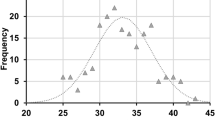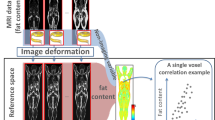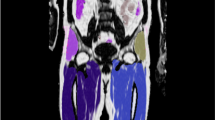Abstract
Objective:
To examine five available software packages for the assessment of abdominal adipose tissue with magnetic resonance imaging, compare their features and assess the reliability of measurement results.
Design:
Feature evaluation and test–retest reliability of softwares (NIHImage, SliceOmatic, Analyze, HippoFat and EasyVision) used in manual, semi-automated or automated segmentation of abdominal adipose tissue.
Subjects:
A random sample of 15 obese adults with type 2 diabetes.
Measurements:
Axial T1-weighted spin echo images centered at vertebral bodies of L2–L3 were acquired at 1.5 T. Five software packages were evaluated (NIHImage, SliceOmatic, Analyze, HippoFat and EasyVision), comparing manual, semi-automated and automated segmentation approaches. Images were segmented into cross-sectional area (CSA), and the areas of visceral (VAT) and subcutaneous adipose tissue (SAT). Ease of learning and use and the design of the graphical user interface (GUI) were rated. Intra-observer accuracy and agreement between the software packages were calculated using intra-class correlation. Intra-class correlation coefficient was used to obtain test–retest reliability.
Results:
Three of the five evaluated programs offered a semi-automated technique to segment the images based on histogram values or a user-defined threshold. One software package allowed manual delineation only. One fully automated program demonstrated the drawbacks of uncritical automated processing. The semi-automated approaches reduced variability and measurement error, and improved reproducibility. There was no significant difference in the intra-observer agreement in SAT and CSA. The VAT measurements showed significantly lower test–retest reliability. There were some differences between the software packages in qualitative aspects, such as user friendliness.
Conclusion:
Four out of five packages provided essentially the same results with respect to the inter- and intra-rater reproducibility. Our results using SliceOmatic, Analyze or NIHImage were comparable and could be used interchangeably. Newly developed fully automated approaches should be compared to one of the examined software packages.
This is a preview of subscription content, access via your institution
Access options
Subscribe to this journal
Receive 12 print issues and online access
$259.00 per year
only $21.58 per issue
Buy this article
- Purchase on Springer Link
- Instant access to full article PDF
Prices may be subject to local taxes which are calculated during checkout





Similar content being viewed by others
References
Banerji MA, Faridi N, Atluri R, Chaiken RL, Lebovitz HE . Body composition, visceral fat, leptin, and insulin resistance in Asian Indian men. J Clin Endocrinol Metab 1999; 84: 137–144.
Thomas EL, Hamilton G, Patel N, O'Dwyer R, Dore CJ, Goldin RD et al. Hepatic triglyceride content and its relation to body adiposity: a magnetic resonance imaging and proton magnetic resonance spectroscopy study. Gut 2005; 54: 122–127.
Diehl AM, Li ZP, Lin HZ, Yang SQ . Cytokines and the pathogenesis of non-alcoholic steatohepatitis. Gut 2005; 54: 303–306.
Sironi AM, Gastaldelli A, Mari A, Ciociaro D, Postano V, Buzzigoli E et al. Visceral fat in hypertension: influence on insulin resistance and beta-cell function. Hypertension 2004; 44: 127–133.
Kuk JL, Church TS, Blair SN, Ross R . Does measurement site for visceral and abdominal subcutaneous adipose tissue alter associations with the metabolic syndrome? Diabetes Care 2006; 29: 679–684.
Kuk JL, Nichaman MZ, Church TS, Blair SN, Ross R . Liver fat is not a marker of metabolic risk in lean premenopausal women. Metabolism 2004; 53: 1066.
Machann J, Thamer C, Schnoedt B, Haap M, Haring H-U, Claus D et al. Standardized assessment of whole body adipose tissue topography by MRI. J Magn Reson Imaging 2005; 21: 455–462.
Durnin JVG, Womersley J . Body fat assessment from total body density and its estimate from skinfold thicknesses: measurements on 481 men and women aged from 16 to 72 years. Br J Nutr 1974; 32: 77–87.
Garrow JS, Stalley S, Diethelm R, Pittet P, Hesp R, Halliday D . A new method for measuring the body density of obese adults. Br J Nutr 1979; 42: 173–183.
Segal KR, Gutin B, Presta E, Wang J, Van Itallie TB . Estimation of human body composition by electrical impedance methods: a comparative study. J Appl Physiol 1985; 58: 1565–1571.
Svendsen OL, Hassager C, Christiansen C . Age- and menopause-associated variations in body composition and fat distribution in healthy women as measured by dual-energy X-ray absorptiometry. Metabolism 1995; 44: 369–373.
Mazess RB, Barden HS, Bisek JP, Hanson J . Dual-energy X-ray absorptiometry for total-body and regional bone-mineral and soft-tissue composition. Am J Clin Nutr 1990; 51: 1106–1112.
Sohlström A, Wahlund LO, Forsum E . Adipose tissue distribution as assessed by magnetic resonance imaging and total body fat by magnetic resonance imaging, underwater weighing and body-water dilution in healthy women. Am J Clin Nutr 1993; 58: 830–838.
Ross R, Leger L, Guardo R, De Guise J, Pike BG . Adipose tissue volume measured by magnetic resonance imaging and computerized tomography in rats. J Appl Physiol 1991; 70: 2164–2172.
Lovejoy JC, Smith SR, Rood JC . Comparison of regional fat distribution and health risk factors in middle-aged white and African American women: the healthy transitions study. Obes Res 2001; 9: 10–16.
Smith SR, Lovejoy JC, Greenway F, Ryan D, deJonge L, de la Bretonne J et al. Contributions of total body fat, abdominal subcutaneous adipose tissue compartments, and visceral adipose tissue to the metabolic complications of obesity. Metabolism 2001; 50: 425–435.
Ross R . Magnetic resonance imaging provides new insights into the characterization of adipose and lean tissue distribution. Can J Physiol Pharmacol 1996; 74: 778–785.
Donnelly LF, O'Brien KJ, Dardzinski BJ, Poe SA, Bean JA, Holland SK et al. Using a phantom to compare MR techniques for determining the ratio of intraabdominal to subcutaneous adipose tissue. AJR Am J Roentgenol 2003; 180: 993–998.
Peng Q, McColl RW, Wang J, Chia JM, Weatherall PT . Water-saturated three-dimensional balanced steady-state free precession for fast abdominal fat quantification. J Magn Reson Imaging 2005; 21: 263–271.
Fowler PA, Fuller MF, Glasbey CA, Cameron GG, Foster MA . Validation of the in vivo measurement of adipose tissue by magnetic resonance imaging of lean and obese pigs. Am J Clin Nutr 1992; 56: 7–13.
Ishikawa M, Koga K . Measurement of abdominal fat by magnetic resonance imaging of OLETF rats, an animal model of NIDDM. Magn Reson Imaging 1998; 16: 45–53.
Abate N, Burns D, Peshock RM, Garg A, Grundy SM . Estimation of adipose tissue mass by magnetic resonance imaging: validation against dissection in human cadavers. J Lipid Res 1994; 35: 1490–1496.
Foster MA, Hutchison JM, Mallard JR, Fuller M . Nuclear magnetic resonance pulse sequence and discrimination of high- and low-fat tissues. Magn Reson Imaging 1984; 2: 187–192.
Purnell JQ, Kahn SE, Schwartz RS, Brunzell JD . Relationship of insulin sensitivity and ApoB levels to intra-abdominal fat in subjects with familial combined hyperlipidemia. Arterioscler Thromb Vasc Biol 2001; 21: 567–572.
Gray DS, Fujioka K, Colletti PM, Kim H, Devine W, Cuyegkeng T et al. Magnetic-resonance imaging used for determining fat distribution in obesity and diabetes. Am J Clin Nutr 1991; 54: 623–627.
Ross R, Goodpaster B, Kelley D, Boada F . Magnetic resonance imaging in human body composition research. From quantitative to qualitative tissue measurement. Ann N Y Acad Sci 2000; 904: 12–17.
Ross R, Rissanen J . Mobilization of visceral and subcutaneous adipose tissue in response to energy restriction and exercise. Am J Clin Nutr 1994; 60: 695–703.
Ross R, Rissanen J, Pedwell H, Clifford J, Shragge P . Influence of diet and exercise on skeletal muscle and visceral adipose tissue in men. J Appl Physiol 1996; 81: 2445–2455.
Abate N, Garg A, Coleman R, Grundy SM, Peshock RM . Prediction of total subcutaneous abdominal, intraperitoneal, and retroperitoneal adipose tissue masses in men by a single axial magnetic resonance imaging slice. Am J Clin Nutr 1997; 65: 403–408.
Han TS, Kelly IE, Walsh K, Greene RM, Lean ME . Relationship between volumes and areas from single transverse scans of intra-abdominal fat measured by magnetic resonance imaging. Int J Obes Relat Metab Disord 1997; 21: 1161–1166.
Kuk JL, Lee S, Heymsfield SB, Ross R . Waist circumference and abdominal adipose tissue distribution: influence of age and sex. Am J Clin Nutr 2005; 81: 1330–1334.
Shen W, Punyanitya M, Wang Z, Gallagher D, St-Onge MP, Albu J et al. Visceral adipose tissue: relations between single-slice areas and total volume. Am J Clin Nutr 2004; 80: 271–278.
Thomas EL, Bell JD . Influence of undersampling on magnetic resonance imaging measurements of intra-abdominal adipose tissue. Int J Obes Relat Metab Disord 2003; 27: 211–218.
Gastaldelli A, Sironi AM, Ciociaro D, Positano V, Buzzigoli E, Giannessi D et al. Visceral fat and beta cell function in non-diabetic humans. Diabetologia 2005; 48: 2090–2096.
Gastaldelli SA, Mari A, Ciociaro D, Positano V, Buzzigoli E, Pettiti LM et al. Visceral fat accumulation and beta-cell function in nondiabetic subjects. Diabetes 2004; 53 (Suppl): A571.
Positano V, Gastaldelli A, Sironi AM, Santarelli MF, Lombardi M, Landini L . An accurate and robust method for unsupervised assessment of abdominal fat by MRI. J Magn Reson Imaging 2004; 20: 684–689.
Liou TH, Chan WP, Pan LC, Lin PW, Chou P, Chen CH . Fully automated large-scale assessment of visceral and subcutaneous abdominal adipose tissue by magnetic resonance imaging. Int J Obes (Lond) 2006; 5: 844–852.
Yang G, Myerson S, Chabat F, Pennell DJ, Firmin DN . Automatic MRI adipose tissue mapping using overlapping mosaics. MAGMA 2002; 14: 39–44.
Jin Y, Imielinska CZ, Laine AF, Udupa J, Shen W, Heymsfield SB . Segmentation and evaluation of adipose tissue from whole body MRI scans. MICCAI'03; November 2003; Montreal, Canada. Part I, pp 635–642.
Ilea D, Ghita O, Robinson K, Sadleirb R, Lynch M, Brennan D et al. In: Proceeedings of Optimization of Electrical and Electronic Equipment. Brasov, Romania, May 20–21, 2004, pp 227–232.
Elbers JM, Haumann G, Asscheman H, Seidell JC, Gooren LJ . Reproducibility of fat area measurements in young, non-obese subjects by computerized analysis of magnetic resonance images. Int J Obes Relat Metab Disord 1997; 21: 1121–1129.
Gronemeyer SA, Steen RG, Kauffman WM, Reddick WE, Glass JO . Fast adipose tissue (FAT) assessment by MRI. Magn Reson Imaging 2000; 18: 815–818.
Poll LW, Wittsack HJ, Koch JA, Willers R, Scherer A, Kapitza C et al. Quantification of total abdominal fat volumes using magnetic resonance imaging. Eur J Med Res 2002; 7: 347–352.
Poll L, Wittsack HJ, Willers R, Modder U, Heinemann L, Kapitza C et al. Correlation between anthropometric parameters and abdominal fat volumes assessed by a magnetic resonance imaging method in patients with diabetes. Diabetes Technol Ther 2004; 6: 844–849.
Poll WL, Wittsack HJ, Koch JA, Willers R, Cohnen M, Kapitza C et al. A rapid and reliable semiautomated method for measurement of total abdominal fat volumes using magnetic resonance imaging. Magn Reson Imaging 2003; 21: 631–636.
Song T, An J, Chen Q, Lee V, Laine V 2005 Assessment of adipose tissue from whole body 3T MRI scans. 27th Annual International Conference IEEE Engineering in Medicine and Biology Society (EMBS); 1–4 September 2005; Shanghai, China.
Brennan DPW, Robinson K, Ghita O, O'Brien J, Sadleir R, Eustace S . Rapid automated measurement of body fat distribution from whole-body MRI. AJR Am J Roentgenol 2005; 185: 418–423.
Ryan DH, Espeland MA, Foster GD, Haffner SM, Hubbard VS, Johnson KC et al. Look AHEAD (Action for Health in Diabetes): design and methods for a clinical trial of weight loss for the prevention of cardiovascular disease in type 2 diabetes. Control Clin Trials 2003; 24: 610–628.
Barnard ML, Schwieso JE, Thomas EL, Bell JD, Saeed N, Frost G et al. Development of a rapid and efficient magnetic resonance imaging technique for analysis of body fat distribution. NMR Biomed 1996; 9: 156–164.
Bonora E, Micciolo R, Ghiatas AA, Lancaster JL, Alyassin A, Muggeo M et al. Is it possible to derive a reliable estimate of human visceral and subcutaneous abdominal adipose tissue from simple anthropometric measurements? Metabolism 1995; 44: 1617–1625.
Busetto L, Tregnaghi A, Bussolotto M, Sergi G, Beninca P, Ceccon A et al. Visceral fat loss evaluated by total body magnetic resonance imaging in obese women operated with laparoscopic adjustable silicone gastric banding. Int J Obes Relat Metab Disord 2000; 24: 60–69.
Changani KK, Nicholson A, White A, Latcham JK, Reid DG, Clapham JC . A longitudinal magnetic resonance imaging (MRI) study of differences in abdominal fat distribution between normal mice, and lean overexpressers of mitochondrial uncoupling protein-3 (UCP-3). Diabetes Obes Metab 2003; 5: 99–105.
Concepcion L, Marti-Bonmati L, Aliaga R, Delgado F, Morillas C, Hernandez A . Abdominal fat assessment by magnetic resonance: comparison with biometric profiles and cardiovascular risk markers. Med Clin (Barc) 2001; 117: 366–369.
Gautier JF, Mourier A, de Kerviler E, Tarentola A, Bigard AX, Villette JM et al. Evaluation of abdominal fat distribution in noninsulin-dependent diabetes mellitus: relationship to insulin resistance. J Clin Endocrinol Metab 1998; 83: 1306–1311.
Janssen I, Ross R . Effects of sex on the change in visceral, subcutaneous adipose tissue and skeletal muscle in response to weight loss. Int J Obes Relat Metab Disord 1999; 23: 1035–1046.
Kamel EG, McNeill G, Van Wijk MC . Change in intra-abdominal adipose tissue volume during weight loss in obese men and women: correlation between magnetic resonance imaging and anthropometric measurements. Int J Obes Relat Metab Disord 2000; 24: 607–613.
Kanaley JA, Giannopoulou I, Tillapaugh-Fay G, Nappi JS, Ploutz-Snyder LL . Racial differences in subcutaneous and visceral fat distribution in postmenopausal black and white women. Metabolism 2003; 52: 186–191.
Kanaley JA, Sames C, Swisher L, Swick AG, Ploutz-Snyder LL, Steppan CM et al. Abdominal fat distribution in pre- and postmenopausal women: the impact of physical activity, age, and menopausal status. Metabolism 2001; 50: 976–982.
Lee S, Janssen I, Ross R . Interindividual variation in abdominal subcutaneous and visceral adipose tissue: influence of measurement site. J Appl Physiol 2004; 97: 948–954.
Ohsuzu F, Kosuda S, Takayama E, Yanagida S, Nomi M, Kasamatsu H et al. Imaging techniques for measuring adipose-tissue distribution in the abdomen: a comparison between computed tomography and 1.5-tesla magnetic resonance spin-echo imaging. Radiat Med 1998; 16: 99–107.
Ross R, Janssen I, Dawson J, Kungl AM, Kuk JL, Wong SL et al. Exercise-induced reduction in obesity and insulin resistance in women: a randomized controlled trial. Obes Res 2004; 12: 789–798.
Ryu JE, Craven TE, MacArthur RD, Hinson WH, Bond MG, Hagaman AP et al. Relationship of intraabdominal fat as measured by magnetic resonance imaging to postprandial lipemia in middle-aged subjects. Am J Clin Nutr 1994; 60: 586–591.
Sobol W, Rossner S, Hinson B, Hiltbrandt E, Karstaedt N, Santago P et al. Evaluation of a new magnetic resonance imaging method for quantitating adipose tissue areas. Int J Obes 1991; 15: 589–599.
Szklo MNF . Chapter 8: quality assurance and control. Epidemiology: Beyond the Basics. Aspen Publishers Inc.: Gaithersberg, MD, 2000; 343–404.
Chan DC, Watts GF, Barrett PH . Comparison of intraperitoneal and posterior subcutaneous abdominal adipose tissue compartments as predictors of VLDL apolipoprotein B-100 kinetics in overweight/obese men. Diabetes Obes Metab 2003; 5: 202–206.
Chan DC, Watts GF, Sussekov AV, Barrett PH, Yang Z, Hua J et al. Adipose tissue compartments and insulin resistance in overweight-obese Caucasian men. Diabetes Res Clin Pract 2004; 63: 77–85.
Machann J, Thamer C, Schnoedt B, Stefan N, Stumvoll M, Haring H-U et al. Age and gender related effects on adipose tissue compartments of subjects with increased risk for type 2 diabetes: a whole body MRI/MRS study. MAGMA 2005; 18: 128–137.
Thamer C, Machann J, Haap M, Stefan N, Heller E, Schnodt B et al. Intrahepatic lipids are predicted by visceral adipose tissue mass in healthy subjects. Diabetes Care 2004; 27: 2726–2729.
Tintera J, Harantova P, Suchanek P, Dvorakova A, Adamova M, Hajek M et al. Quantification of intra-abdominal fat during controlled weight reduction: assessment using the water-suppressed breath – hold MRI technique. Physiol Res 2004; 53: 229–234.
Miyazaki Y, Glass L, Triplitt C, Wajcberg E, Mandarino LJ, DeFronzo RA . Abdominal fat distribution and peripheral and hepatic insulin resistance in type 2 diabetes mellitus. Am J Physiol Endocrinol Metab 2002; 283: E1135–E1143.
Seppala-Lindroos A, Vehkavaara S, Hakkinen AM, Goto T, Westerbacka J, Sovijarvi A et al. Fat accumulation in the liver is associated with defects in insulin suppression of glucose production and serum free fatty acids independent of obesity in normal men. J Clin Endocrinol Metab 2002; 87: 3023–3028.
Acknowledgements
The study was supported in part by NIH/NIDDK Grant RO1-DK060427 and UO1-DK57149. We thank Charlette Diggs, Project Coordinator for the Fatty Liver Ancillary Study, Kathleen Kahl and Terry Brawner, MR technicians, and the participants for their time and commitment.
Author information
Authors and Affiliations
Corresponding author
Rights and permissions
About this article
Cite this article
Bonekamp, S., Ghosh, P., Crawford, S. et al. Quantitative comparison and evaluation of software packages for assessment of abdominal adipose tissue distribution by magnetic resonance imaging. Int J Obes 32, 100–111 (2008). https://doi.org/10.1038/sj.ijo.0803696
Received:
Revised:
Accepted:
Published:
Issue Date:
DOI: https://doi.org/10.1038/sj.ijo.0803696
Keywords
This article is cited by
-
Abdominal fat quantification using convolutional networks
European Radiology (2023)
-
Abdominal adipose tissue and type 2 diabetic kidney disease: adipose radiology assessment, impact, and mechanisms
Abdominal Radiology (2023)
-
Initial experience with the graphical user interface for laser parameters setting of a new thulium fibre laser source device for urinary pathologies treatment
World Journal of Urology (2023)
-
The relationships between physical activity, lumbar multifidus muscle morphology, and low back pain from childhood to early adulthood: a 12-year longitudinal study
Scientific Reports (2022)
-
Both intermuscular fat and LVEF decline promote heart failure symptoms in cancer survivors
Cardio-Oncology (2021)



